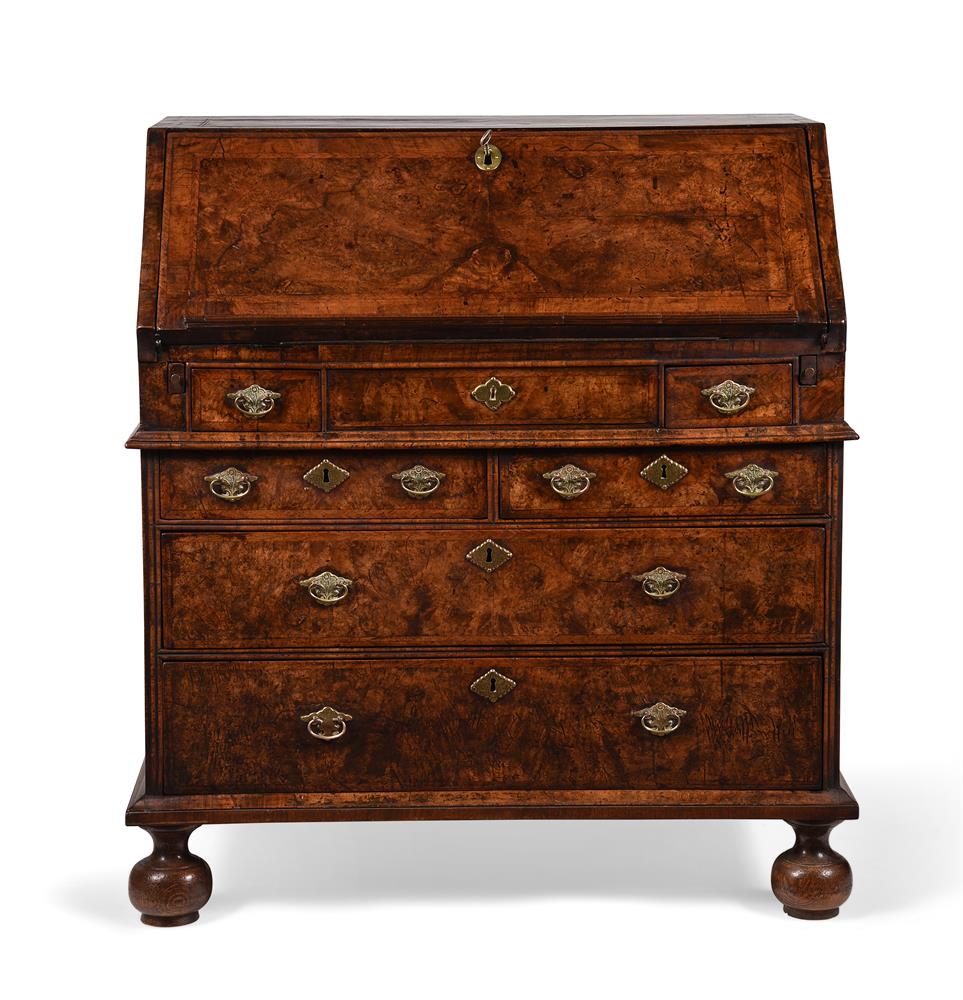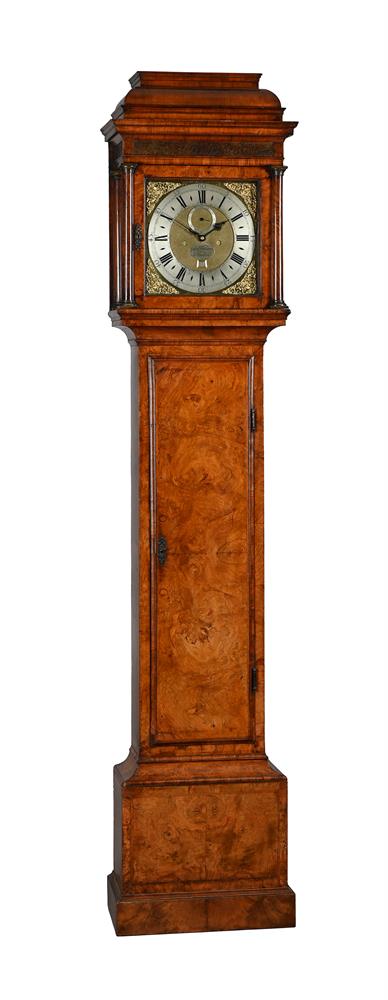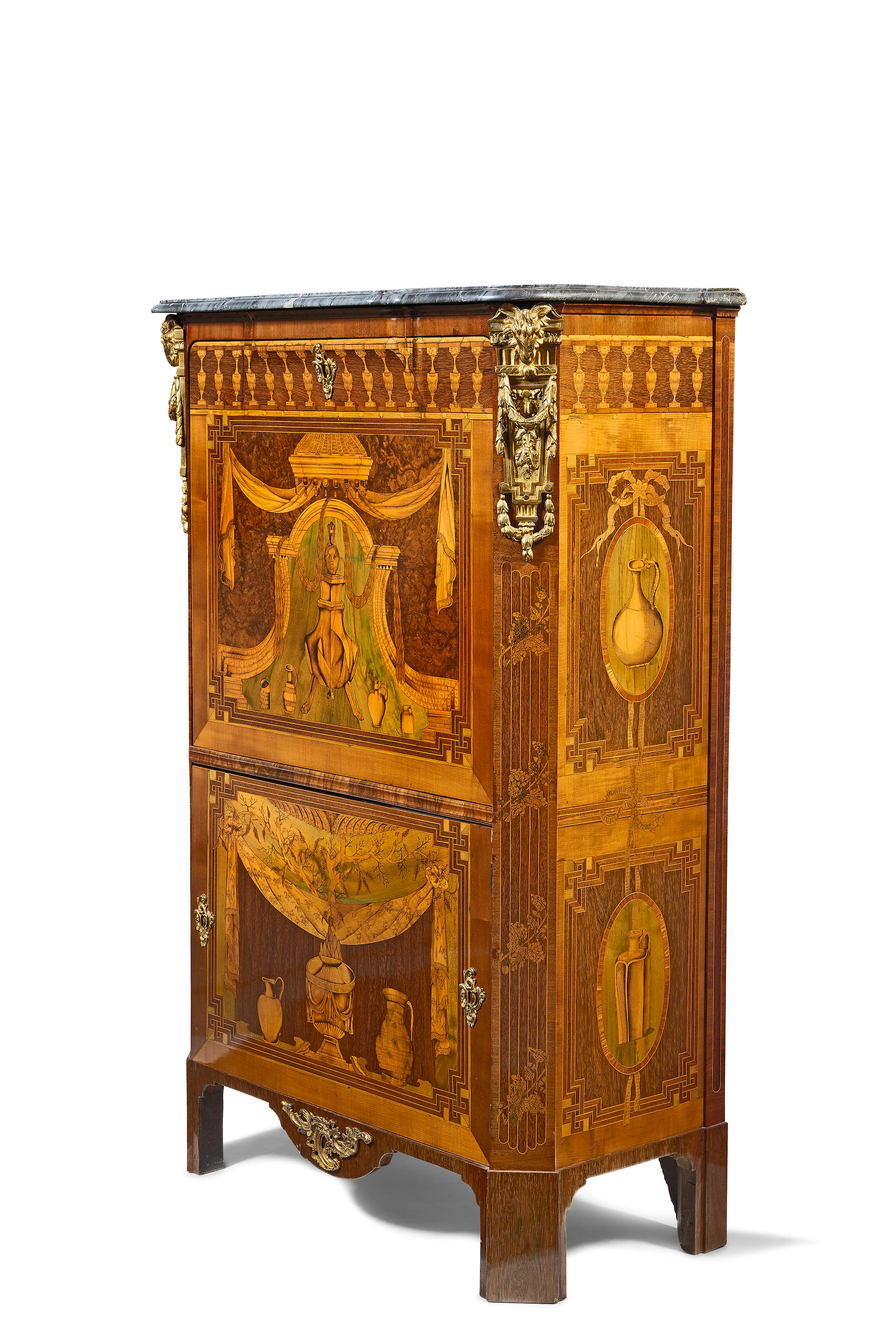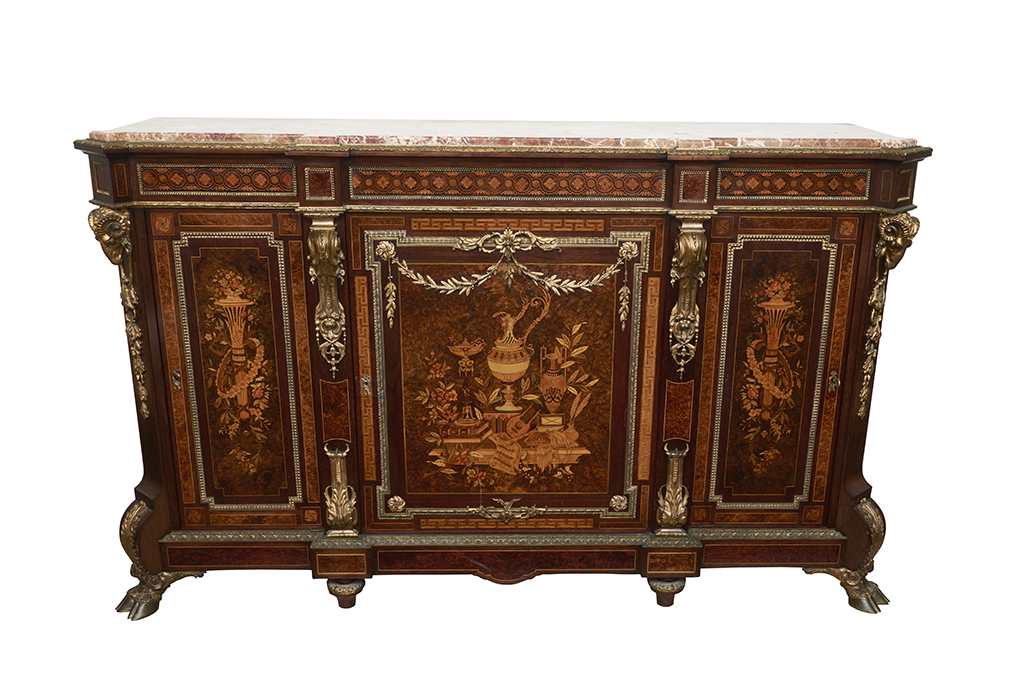An Important burr walnut longcase clock of three month duration with pull quarter-repeat on six bells Simon DeCharmes, London, with movement and dial supplied for the clock by Claude DuChesne, dated 1717 The substantial eight finned-pillar rack and bell striking movement with five-wheel trains, rise/fall pendulum regulation and pull-quarter repeat on six bells, the 24 hour wheel inscribed Claudius Du Chesne Londini, 24th May 1717, the 12 inch gilt brass break-arch dial with calendar aperture, turned collets for the winding holes, pierced steel hands and silvered subsidiary seconds ring to the finely matted centre within an applied silvered Roman numeral chapter ring with fleur-de-lys half hour markers and Arabic five minutes to the outer track, the angles with gilt cast mask-and-scroll spandrels, beneath arch with central domed silvered boss boldly signed Simon DeCharmes, London, flanked by subsidiary strike/silent and regulation dials with matted centres and within conforming foliate scroll relief infill, the case of impressive proportions and fine colour, with tall ogee domed caddy applied with three cast brass ball-and-spire finials above blind fret break-fronted box upstand incorporating ogee moulded break-arch frieze with conforming fret infill, the hood door with applied half-round gilt brass dial surround flanked by integral columns with gilt caps and bases, the sides with brass-edged large rectangular windows and dressed with quarter columns backed onto bargeboards to the rear edges, the trunk with book-matched veneers to the concave throat and unusual applied break-arch mouldings above herringbone banded finely figured trunk door, on conforming banded panel plinth base with double skirt, 253cm excluding finials, 271cm high overall. Provenance: The property of a Lady Claude DuChesne and Simon DeCharmes were both of French Huguenot immigrant extraction. DuChesne originated from Paris and was made Free of the Clockmakers Company in 1693, De Charmes was made a Free brother in 1691. Both specialised in producing very distinctive high quality clocks usually of complex specification, often playing music or with astronomical features, many for export to Northern Europe. When the work of both makers is compared it becomes apparent that they must have had a close working relationship. A good example illustrating the similarities of both makers work, can be seen when comparing two japanned musical table clocks sold at SothebyÆs in 2006/7. The first example, by DuChesne, sold in London on 14/12/06 (lot 66) the second, by DeCharmes, also sold in London, on 25/04/07 (lot 81). Both these clocks are of similar specification and are in near identical cases, only differing slightly in detail. The dial layout of the current lot with two subsidiary dials beneath a central feature (either signature plaque or third dial) appears to have been the favoured format of DuChesne at this period. This coupled with the use of fitted disc collets around the winding holes (also favoured by DuChesne) and the fact that the 24 hour wheel is signed by him confirms that the movement was supplied by DuChesne to DeCharmes for use in this clock, complete with the finished dial to which he had only to add a signed boss. The case on the other hand exhibits details which appear to be unique to DeCharmes, most noticeably the unusual break-arch moulding above the trunk door. This feature (coupled with directly comparable caddy configurations and break-arch detail immediately above the arch of the case) can be seen on two other examples by DeCharmes. The first (now with later marquetry) was sold by SothebyÆs, London on 19/12/00 (lot 335) the second also sold by SothebyÆs in London on 23/03/99 lot 252. The case can also be compared with a marquetry example housing a grande sonnerie movement by Quare (number 145) illustrated in Robinson, Tom The LONGCASE CLOCK pages144-5 which Robinson dates to 1716-18. The brass half-round moulding applied to the front door and sid
An Important burr walnut longcase clock of three month duration with pull quarter-repeat on six bells Simon DeCharmes, London, with movement and dial supplied for the clock by Claude DuChesne, dated 1717 The substantial eight finned-pillar rack and bell striking movement with five-wheel trains, rise/fall pendulum regulation and pull-quarter repeat on six bells, the 24 hour wheel inscribed Claudius Du Chesne Londini, 24th May 1717, the 12 inch gilt brass break-arch dial with calendar aperture, turned collets for the winding holes, pierced steel hands and silvered subsidiary seconds ring to the finely matted centre within an applied silvered Roman numeral chapter ring with fleur-de-lys half hour markers and Arabic five minutes to the outer track, the angles with gilt cast mask-and-scroll spandrels, beneath arch with central domed silvered boss boldly signed Simon DeCharmes, London, flanked by subsidiary strike/silent and regulation dials with matted centres and within conforming foliate scroll relief infill, the case of impressive proportions and fine colour, with tall ogee domed caddy applied with three cast brass ball-and-spire finials above blind fret break-fronted box upstand incorporating ogee moulded break-arch frieze with conforming fret infill, the hood door with applied half-round gilt brass dial surround flanked by integral columns with gilt caps and bases, the sides with brass-edged large rectangular windows and dressed with quarter columns backed onto bargeboards to the rear edges, the trunk with book-matched veneers to the concave throat and unusual applied break-arch mouldings above herringbone banded finely figured trunk door, on conforming banded panel plinth base with double skirt, 253cm excluding finials, 271cm high overall. Provenance: The property of a Lady Claude DuChesne and Simon DeCharmes were both of French Huguenot immigrant extraction. DuChesne originated from Paris and was made Free of the Clockmakers Company in 1693, De Charmes was made a Free brother in 1691. Both specialised in producing very distinctive high quality clocks usually of complex specification, often playing music or with astronomical features, many for export to Northern Europe. When the work of both makers is compared it becomes apparent that they must have had a close working relationship. A good example illustrating the similarities of both makers work, can be seen when comparing two japanned musical table clocks sold at SothebyÆs in 2006/7. The first example, by DuChesne, sold in London on 14/12/06 (lot 66) the second, by DeCharmes, also sold in London, on 25/04/07 (lot 81). Both these clocks are of similar specification and are in near identical cases, only differing slightly in detail. The dial layout of the current lot with two subsidiary dials beneath a central feature (either signature plaque or third dial) appears to have been the favoured format of DuChesne at this period. This coupled with the use of fitted disc collets around the winding holes (also favoured by DuChesne) and the fact that the 24 hour wheel is signed by him confirms that the movement was supplied by DuChesne to DeCharmes for use in this clock, complete with the finished dial to which he had only to add a signed boss. The case on the other hand exhibits details which appear to be unique to DeCharmes, most noticeably the unusual break-arch moulding above the trunk door. This feature (coupled with directly comparable caddy configurations and break-arch detail immediately above the arch of the case) can be seen on two other examples by DeCharmes. The first (now with later marquetry) was sold by SothebyÆs, London on 19/12/00 (lot 335) the second also sold by SothebyÆs in London on 23/03/99 lot 252. The case can also be compared with a marquetry example housing a grande sonnerie movement by Quare (number 145) illustrated in Robinson, Tom The LONGCASE CLOCK pages144-5 which Robinson dates to 1716-18. The brass half-round moulding applied to the front door and sid












Testen Sie LotSearch und seine Premium-Features 7 Tage - ohne Kosten!
Lassen Sie sich automatisch über neue Objekte in kommenden Auktionen benachrichtigen.
Suchauftrag anlegen